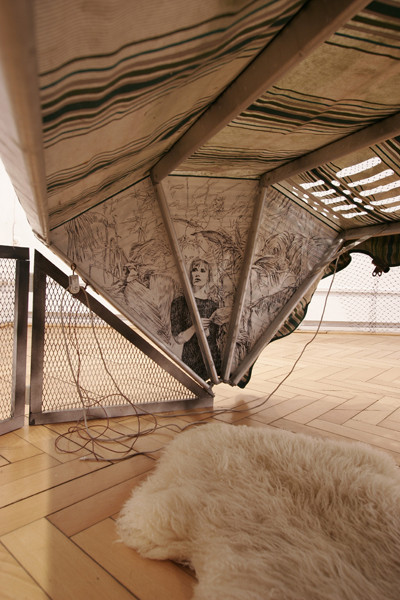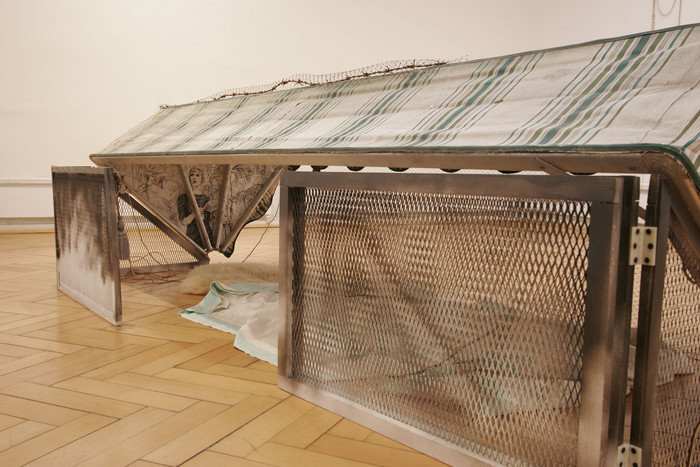Kerstin Kartscher
15 Mar - 10 May 2008
Kerstin Kartscher
remote bedroom
15.03.-03.05.2008
Vernissage: 14.03.2008
Within the framework of the Suzie Q projects, Birgid Uccia and Bob van Orsouw are pleased to present the first solo exhibition in Switzerland of the drawings and installations of Kerstin Kartscher (*1966), who lives and works in London.
At the centre of the presentation is the installation “Die Sabinerin” (2005), composed of an assemblage of various materials (an awning, an animal pelt, barrier elements, bedding, etc.). At first sight it recalls a tent-like refuge. A closer look proves it is in no case a protective shelter, since it is open on all sides. One is more inclined to see in it the precarious and provisional encampment of a habitat for the homeless. To this extent the installation appears ambivalent and fragile. Kartscher seems here to be evoking the impossibility of a genuine haven, rooting it, instead, in the fictive world of the imagination.
Just as heroines crowd Kartscher’s drawings so does the title of the installation “Die Sabinerin” summon up the heroism anchored in mythology (the Sabine women abducted by the Romans bravely threw themselves between the warring factions' battle lines, bringing about peace). Directly on the inside flaps of the awning a figure of a woman is drawn in analogy to Joseph Losey’s film “Eve” (1962). Eve was played by Jeanne Moreau, one of the famous screen divas of the 20th century. The theme of female power and autonomy in a reversal of patriarchal dominance also runs as a leitmotif through Kartscher’s drawings.
The artist treats the drawing as an autonomous medium that is neither a sketch nor a preliminary study. As in the installations, the depiction of architectural props and various fragments of reality generates parallel worlds. Tropical vegetation, phantasmal landscapes and dream-like episodes call up associations of imaginary places where space and time open into an unknown, private cosmos that weaves a mysterious spell over the viewer. The drawings are dominated by a style that recalls the clear lines of Japanese woodcuts or illustration techniques. In his catalogue contribution to Kartscher’s solo exhibition at the Tate, St. Ives (2005/06), Jan Verwoert wrote: “Each drawing is a theatre of the mind [...] to which one can retreat and be free to dwell on feelings and thoughts which the outside world leaves little room for.”
Birgid Uccia
remote bedroom
15.03.-03.05.2008
Vernissage: 14.03.2008
Within the framework of the Suzie Q projects, Birgid Uccia and Bob van Orsouw are pleased to present the first solo exhibition in Switzerland of the drawings and installations of Kerstin Kartscher (*1966), who lives and works in London.
At the centre of the presentation is the installation “Die Sabinerin” (2005), composed of an assemblage of various materials (an awning, an animal pelt, barrier elements, bedding, etc.). At first sight it recalls a tent-like refuge. A closer look proves it is in no case a protective shelter, since it is open on all sides. One is more inclined to see in it the precarious and provisional encampment of a habitat for the homeless. To this extent the installation appears ambivalent and fragile. Kartscher seems here to be evoking the impossibility of a genuine haven, rooting it, instead, in the fictive world of the imagination.
Just as heroines crowd Kartscher’s drawings so does the title of the installation “Die Sabinerin” summon up the heroism anchored in mythology (the Sabine women abducted by the Romans bravely threw themselves between the warring factions' battle lines, bringing about peace). Directly on the inside flaps of the awning a figure of a woman is drawn in analogy to Joseph Losey’s film “Eve” (1962). Eve was played by Jeanne Moreau, one of the famous screen divas of the 20th century. The theme of female power and autonomy in a reversal of patriarchal dominance also runs as a leitmotif through Kartscher’s drawings.
The artist treats the drawing as an autonomous medium that is neither a sketch nor a preliminary study. As in the installations, the depiction of architectural props and various fragments of reality generates parallel worlds. Tropical vegetation, phantasmal landscapes and dream-like episodes call up associations of imaginary places where space and time open into an unknown, private cosmos that weaves a mysterious spell over the viewer. The drawings are dominated by a style that recalls the clear lines of Japanese woodcuts or illustration techniques. In his catalogue contribution to Kartscher’s solo exhibition at the Tate, St. Ives (2005/06), Jan Verwoert wrote: “Each drawing is a theatre of the mind [...] to which one can retreat and be free to dwell on feelings and thoughts which the outside world leaves little room for.”
Birgid Uccia


